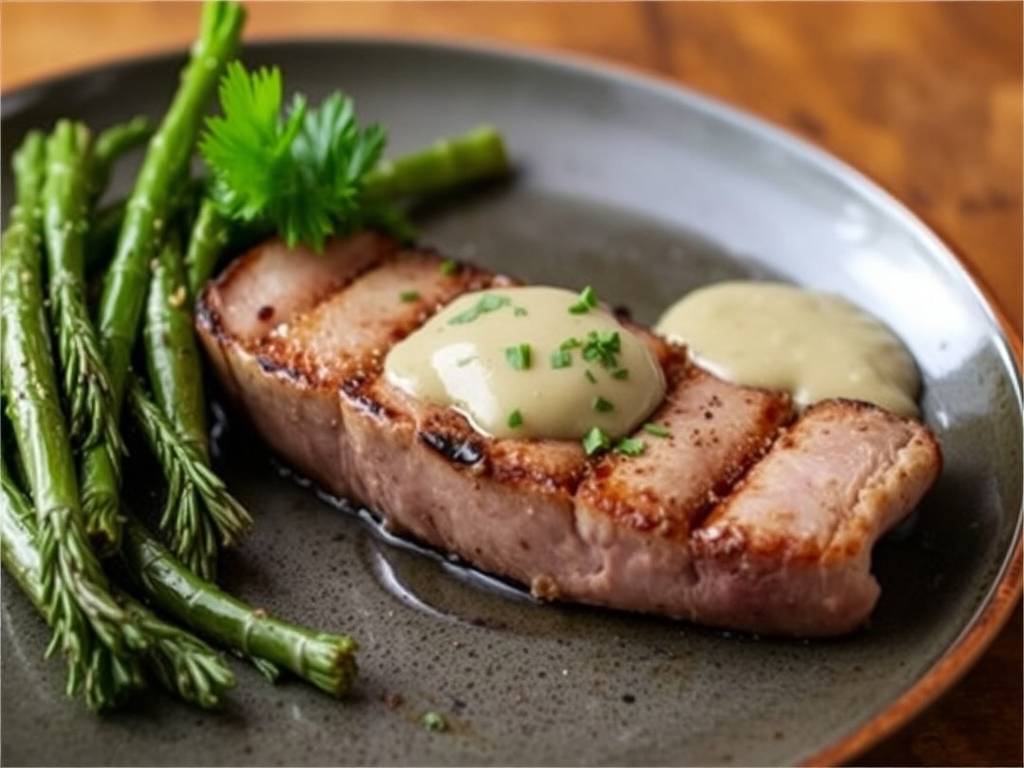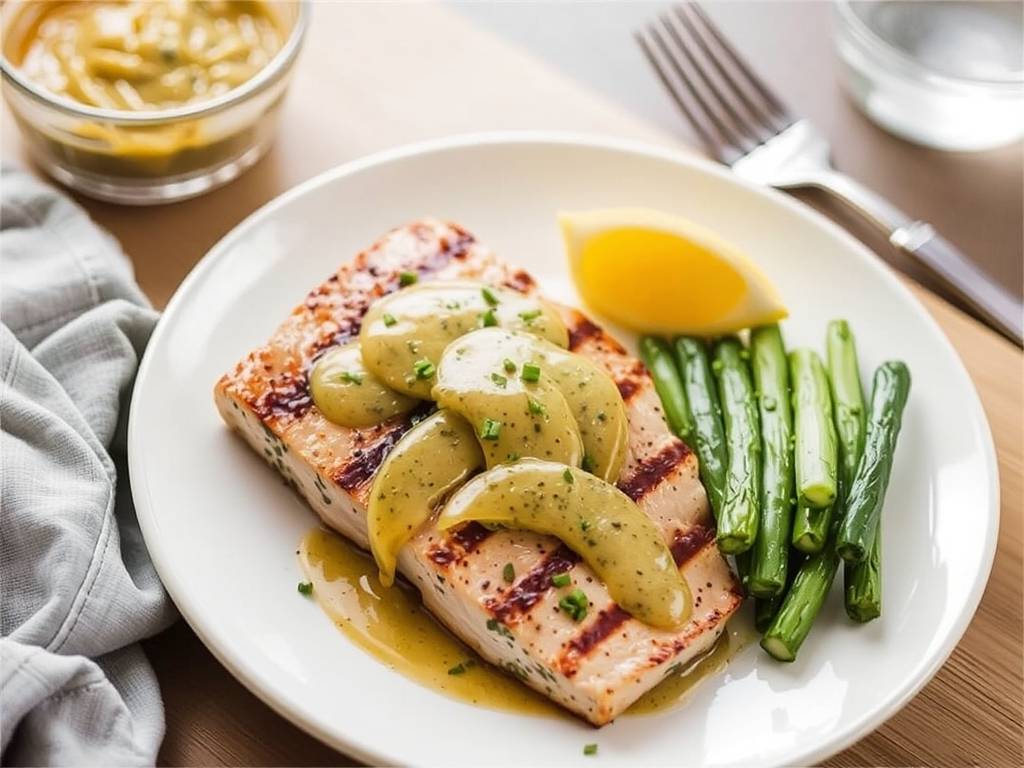The Ultimate Guide to Grilling Perfect Tuna Steaks with a Flavorful Herb Butter Sauce
There's something truly special about a perfectly grilled tuna steak. When done right, it’s a culinary experience that bridges the gap between a hearty meat and the delicate freshness of the sea. That beautiful, firm yet tender texture, the smoky char from the grill, and the rich, savory flavor make it a favorite for seafood lovers. Yet, for many home cooks, the idea of grilling tuna can be intimidating. The fear of overcooking it into a dry, chalky disappointment is real. But I'm here to tell you that achieving a restaurant-quality, medium-rare grilled tuna steak at home is not only possible—it's surprisingly straightforward.
The secret weapon in this culinary adventure? A simple, yet transformative, homemade herb butter sauce. This sauce doesn't just add moisture; it elevates the entire dish, complementing the tuna's natural flavor with the brightness of fresh herbs and the rich depth of butter. This comprehensive guide will walk you through every single step, from selecting the right fish to mastering the grill and whipping up that incredible sauce. We will cover everything you need to know about the best way to grill tuna steaks, ensuring a juicy and flavorful result every single time.

Choosing Your Tuna: The Foundation of Flavor
Your journey to a perfect grilled tuna steak begins at the market. Not all tuna is created equal for grilling. You want a firm, meaty cut that can hold its own on the hot grates.
- Ahi Tuna vs. Yellowfin Tuna: You'll often see the term "Ahi." This typically refers to both Yellowfin and Bigeye tuna. For grilling, both are excellent choices. They have a deep red color, a firm texture, and a mild, clean flavor that stands up beautifully to high heat. When looking for the best tuna for grilling, seek out steaks that are labeled "sashimi-grade" or "sushi-grade." This isn't an official USDA designation, but it indicates that the fish has been handled and frozen to a standard that makes it safe to eat raw or rare—which is exactly our goal.
- What to Look For: A fresh tuna steak should look vibrant and feel firm to the touch. It should have a clean, ocean-fresh smell, not a strong, "fishy" odor. The color should be a consistent, deep red without any brownish spots or discoloration. Aim for steaks that are at least 1-inch thick; this gives you a generous window to develop a good sear while keeping the center beautifully rare.
The Essential Tools for Grilling Tuna
You don't need a professional kitchen setup, but a few key tools will make the process seamless:
- A Hot Grill: Whether you're using a gas grill or a charcoal grill, the key is high, direct heat. A charcoal grill will impart a slightly smokier flavor, but a gas grill offers precise temperature control. Both are fantastic options.
- Tongs: A good pair of long-handled tongs is non-negotiable. You'll use them to flip the steak gently without piercing it and losing its precious juices.
- A Pastry Brush: This will be your best friend for applying oil to the fish and the grill grates, preventing any sticking.
- A Small Saucepan: For creating our magical, easy herb butter sauce for fish.
- An Instant-Read Thermometer: This is the ultimate tool for guaranteeing perfect doneness. While you can gauge by feel, a thermometer takes all the guesswork out of the equation.
Preparing the Tuna Steak for the Grill
Preparation is quick and simple, allowing the quality of the fish to shine.
- Bring to Room Temperature: About 20-30 minutes before grilling, take the tuna steaks out of the refrigerator. Allowing them to come to room temperature is a crucial step for even cooking. A cold steak thrown on a hot grill will seize up and cook unevenly, leaving you with an overcooked exterior and a cold center.
- Pat Dry: Use paper towels to pat the steaks completely dry. A dry surface is the secret to achieving a phenomenal sear, not a steam.
- Season Generously: Drizzle both sides of the steaks lightly with a high-smoke-point oil like avocado oil or grapeseed oil. Extra virgin olive oil can work, but it has a lower smoke point. Then, season liberally with kosher salt and freshly ground black pepper. This simple seasoning enhances the tuna's natural flavor without overpowering it.
Mastering the Grill: Your Step-by-Step Guide to Grilling Tuna
This is where the magic happens. Follow these steps for a foolproof grilled tuna experience.
- Preheat Your Grill: This is the most important step. Crank your gas grill to high or prepare your charcoal grill for direct, high-heat cooking. You want the grates to be screaming hot—around 450-500°F (230-260°C). A properly hot grill is what creates that delicious crust and prevents the fish from sticking.
- Oil the Grates: Just before placing the tuna on the grill, take a folded paper towel, dip it in some oil (using your tongs), and carefully wipe it across the hot grates. You'll hear a satisfying sizzle.
- The Grill Technique: Place your seasoned tuna steaks directly on the hot grates. You should hear an immediate, assertive sizzle. Now, here is the key to how to grill tuna steak without overcooking: DO NOT MOVE IT. Let it cook undisturbed for 1.5 to 2 minutes to develop a deep, brown sear.
- The Flip and Finish: Using your tongs, gently flip the steak. It should release easily from the grates if a good sear has formed. Cook for another 1 to 1.5 minutes on the second side for a rare to medium-rare finish. For a 1-inch thick steak, this total cooking time of 2.5 to 3.5 minutes is usually perfect.
Determining Doneness: The Art of the Perfect Tuna Steak
Unlike chicken or pork, tuna is best enjoyed rare to medium-rare. The center should be warm but still red or pink. Here’s how to tell:
- By Touch: A rare tuna steak will feel very soft, like the fleshy part of your palm below your thumb when your hand is completely relaxed. Medium-rare will have a little more resistance, similar to that same part of your palm when you gently touch your thumb and index finger together.
- By Thermometer (Recommended): This is the most accurate method. Insert an instant-read thermometer into the side of the steak, aiming for the center.
- Rare: 115-125°F (46-52°C) – Deep red center.
- Medium-Rare: 125-135°F (52-57°C) – Warm red or pink center. This is the ideal doneness for most people.
- Medium: 135-145°F (57-63°C) – Pink center, starting to become firm.
- Well-Done: 145°F+ (63°C+) – Firm and fully opaque. We do not recommend grilling tuna to this temperature, as it becomes very dry.
Remember, the tuna will continue to cook for a minute or two after you take it off the grill (this is called "carryover cooking"), so it's wise to remove it from the heat just before it reaches your desired final temperature.
Creating the Star of the Show: The Herb Butter Sauce
While the tuna is resting, you can whip up this incredibly simple and delicious sauce in just a few minutes. This is a classic compound butter, melted into a luscious sauce.
Ingredients for the Herb Butter Sauce:
- 4 tablespoons (1/2 stick) of unsalted butter
- 1 small shallot, finely minced
- 1 clove garlic, minced
- 2 tablespoons of fresh lemon juice
- 2 tablespoons of mixed fresh herbs, finely chopped (parsley, chives, and dill are a classic combination)
- Zest of half a lemon
- Salt and freshly ground black pepper to taste
Instructions for the Perfect Pan Sauce for Grilled Tuna:
- In your small saucepan, melt the butter over medium heat.
- Add the minced shallot and cook for 1-2 minutes until it becomes fragrant and slightly softened. Be careful not to burn the garlic if you add it now, or you can add it 30 seconds later.
- Let the butter cook for another minute until it just starts to foam and take on a faint nutty aroma. This is beurre noisette, or brown butter, and it adds a wonderful depth of flavor.
- Immediately remove the pan from the heat and stir in the fresh lemon juice. It will bubble up—that's normal!
- Stir in your freshly chopped herbs and lemon zest. The fresh herbs will wilt slightly in the warm butter, releasing all their aromatic oils.
- Season with a pinch of salt and a crack of black pepper. Your quick and easy lemon herb butter sauce is ready!
Serving and Presentation: Bringing It All Together
Transfer your beautifully grilled tuna steaks to a cutting board or individual plates. Spoon the warm herb butter sauce generously over the top. The residual heat from the tuna will help the sauce cling to every nook and cranny.
For an elegant presentation, you can slice the tuna steak against the grain into ½-inch thick slices. Fan them out on the plate and drizzle the sauce over them. This not only looks impressive but also makes it easier to eat.
What to Serve with Grilled Tuna Steaks

This flavorful dish pairs wonderfully with a variety of sides. Consider:
- For a Light Meal: A simple arugula salad with a lemon vinaigrette, or a quinoa salad with chopped vegetables.
- For a Heartier Meal: Garlic mashed potatoes, roasted asparagus, or grilled zucchini and summer squash. The creamy potatoes are a fantastic vehicle for that extra herb butter sauce!
Conclusion: Your New Go-To Gourmet Meal
Grilling a perfect tuna steak is a skill that will serve you for a lifetime. It’s a quick, healthy, and incredibly impressive dish to serve for a weeknight dinner or to entertain guests. By focusing on high-quality fish, a searing hot grill, and a simple timing technique, you can consistently achieve a moist, flavorful result. And with the addition of the versatile and delicious homemade herb butter sauce, you transform a simple piece of fish into a gourmet masterpiece. So, fire up that grill, and get ready to enjoy one of the most satisfying seafood experiences right in your own backyard.






发表评论